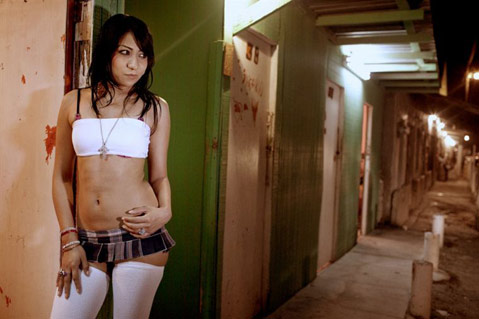Whore’s Glory
An Interview with Director Michael Glawogger

Kicking off with a hypnotic title sequence, this eerily scored (CocoRosie, etc.) tryptic doc travels from Bangkok to Bangladesh to border-town Mexico to assess the state of contemporary prostitution, with all the money, madness, and melancholy moods on surprisingly open display.
Director Michael Glawogger recently sent some notes to my questions via email.
Why did you decide to do a film about prostitution?
The topics are certainly loaded because everyone believes they know some thing about prostitution, particularly when he or she has never been to a brothel, or they know about it from the media or simply from second hand information. I tried to go in with only one expectation: “This is certainly not going to be what I think it is.” I have always felt that prostitution isn’t only about paying somebody for sex. That would be too simple, because when negotiations are over and the deal is done, it would only be about two naked people doing the most intimate of acts. I wanted to try and explore more: What does it do to the hearts, minds, and souls on both sides?
This film features both sex workers and their clients speaking frankly on camera about their lives and why they do what they do. How in the world were you able to get people to open up publicly about buying and selling sex?
All of the working girls were initially reluctant to speak on film. A brothel is the place where you are most unwelcome with a film camera. It is a place of secrecy and privacy for both workers and custo mers. So in the beginning nobody wants to be filmed or photographed. Establishing trust is a very long process. It took a lot of time, patience and persistence. I had to promise the women that the film would not be shown in wide theatrical release in their home countries. With the customers, it was sometimes more difficult because they are not usually the same ones everyday. But like the workers, frequent customers opened up once they got the feeling that we were not there to condemn what they do. In some cases we couldn’t film because not all the customers wanted to be in the film. Then we selected the ones who were willing and for that period of time nobody else could enter the establishment. But there is no situation in the film that would not take place like in the way it is shown.
What were some of the toughest challenges?
In Thailand, the high risk was mainly if the “boss” got nervous, because then we would be kicked out with nothing but lost time and spent money. There were also very strong restrictions imposed by the manager of the establishment. For example, we weren’t allowed to set up any spotlights. However, that ended up creating a very interesting lighting situation, because the glass box was so bright and the client space was so dark. Bangladesh from the standpoint of a filmmaker is maddening. It’s a place that is so alive it simply can’t be controlled. You can only hope that after some time people won’t care that you’re there. One can hardly speak of logistical problems, because things such as logistics don’t even exist there in that sense. And in Mexico, perhaps the biggest obstacle was the complete dependence of the women on their pimps. When they were told that they weren’t allowed to shoot with us, even the women who were our good friends slammed the door in our faces every time.
This has probably one of the more hypnotic opening sequences of any film. How did you select the music to go along with the images you got?
The choice of music was very important to me because both the environment and the lives of the women have a lot to do with music. But you’re always walking on the edge because music in documentary film often has a very interpretive effect. But I increasingly began to realize that this is not just a film about prostitution, but also about the man-woman relationship. Which then meant for me that there could only be love songs and duets. It didn’t matter whether the music sounded interpretive. And then my editor and I totally went for it and began listening to really loud, mostly angry love songs and very affectionate, searching duets. One of the songs is a duet that is based on a poem that I wrote while watching the rushes from Bangladesh. Now the soundtrack is a mix of songs, written score and also the music that is heard and played on site, and it establishes a structure to my musical commentary and the reality.
There’s an actual sex scene toward the end. Tell us a bit more about that.
Originally, I wanted to make a film about prostitution where you don’t see or know what’s actually going on behind the closed doors. But to exclude a sex scene would have meant excluding a major topic. It was clear that I wouldn’t be able to film secretly or without the consent of all parties. I shot a sex scene only in Mexico for practical reasons. The girls in Thailand probably would not have minded but the local censorship bureau would have, and in Bangladesh, this would be out of the question… What’s interesting about the sex scene is that everything between the flirtatious worker and the customer changes the second the door is closed. Their exchange becomes immediately businesslike without being harsh or brutal. Even when the time is up, she’s strict but remains friendly: “Goodbye, come back when you have more money… sweetheart.”
Whore’s Glory screens on Tuesday, January 31, 4:30 p.m. at the Lobero Theatre and again on Thursday, February 2, 10:20 p.m. at the Metro.



